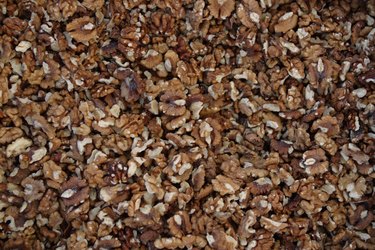
Of the 21 species of walnut around the world, six species are native to North America, and those species range greatly in size from modest shrubs to large trees. The larger walnut trees are adored by the lumber industry for their beautiful hardwood; the wood of the black walnut is highly valued, but claro walnut, the wood of one western species, is even more sought after.
Eastern Black Walnut
Video of the Day
The black walnut (Juglans nigra), also called the eastern black walnut, is the largest of the native American walnut species; it reaches heights of 75 to 100 feet, with a crown spread of a similar size. It is hardy in U.S. Department of Agriculture hardiness zones 4 through 9 and grows best in well-drained soil and full sun. It is prized for its edible nuts, which it produces prolifically, and its attractive wood, which is used in fine furniture, cabinets, veneers and other decorative applications.
Video of the Day
Hinds Walnut
The Hinds walnut (Juglans hindsii) is also sometimes called the northern California black walnut, and in the lumber industry, its wood is referred to as claro walnut. It is one of two American walnut species native to the Pacific Coast. The tree is large, although not as large as the eastern black walnut; it ranges from 30 to 60 feet in height, and the largest Hinds walnut on record measured 80 feet high. Hinds black walnut is hardy in USDA zones 7 through 9 and prefers acidic soil. Unlike the eastern black walnut, it will tolerate partial shade.
California Black Walnut
Another variety of black walnut, the California black walnut (Juglans californica) is sometimes confused with the Hinds black walnut. California black walnut is significantly smaller, reaching only 15 to 30 feet in height, and often grows in a shrub-like form, with several stems rather than a single trunk. The nuts of the California black walnut are also smaller than those of the Hinds walnut; the nuts of the former are usually more than 1 inch in diameter, while those of the latter are generally only about 3/4-inch in diameter.
Wood
The wood of the black walnut is used extensively by furniture makers and woodworkers, and it is one of the most expensive of all domestic hardwoods. It is durable and easy to work, and its unique color produces a rich finish. Claro walnut, the wood of the Hinds walnut tree, tends to be highly figured and is often used to make gunstocks and musical instruments. Claro walnut is typically slightly more expensive than black walnut, and marbled or heavily figured specimens are significantly more expensive.